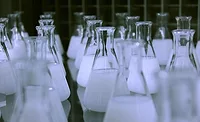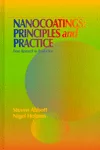Technical Paper Abstracts: Fall 1999
Conference: "Powder Coatings-What's Next?")
Most of the papers presented at major conferences in the United States, such as at the Waterborne, High-Solids and Powder Coating Symposium and the Powder Coating Formulation and Production Conference, are readily available, so this newsletter will focus on papers presented at other locations less well known. Papers presented at foreign locations sometimes give a different insight as to the market and technical direction of the powder coating industry.In this issue, two papers are abstracted from a recent conference, "Powder Coatings-What's Next?" held in March in Birmingham, England. The conference was sponsored by the Paint Research Association (PRA) and the Hill Media Group. Thirteen papers were presented, including topics such as improved manufacturing methods, new application techniques, UV-curable powders and providing faster turn around on delivering powders with a color-matching process utilizing mixing colored powders.
Copies of the papers are available from the Paint Research Association, 8 Waldgrave Rd., Teddington TW11 8LD, UK,
phone 44-0-181-614-4813; fax 44-0-181-614-4812; e-mail, publications@pra.org.uk.

Paper No. 7, "Electromagnetic Brush Technology: Latest Experience"
Presented by: Dr. Detlef Schulze-Hagenest, Michael Huber Munchen GmbH, and co-author Paul Binda, DSM Resins BVSubject: New technique for applying powder to flat stock at high line speeds at low film thickness.
The process is derived
from the well-known copy and laser-printing methods generically referred to as
electromagnetic brush (EMB) technology. Toner (powder) particles are intensively
mixed with the larger carrier particles, which are ferromagnetic and coated with
Teflon or a similar polymer (Figure 1). The powder particles are charged
triboelectrically and adhere to the carrier particles, similar to tribocharged
coating powder particles adhering to a metallic substrate. The combination of
powder and carrier particles is referred to as the developer. The developer is
transported to a rotating drum, which contains permanent magnets. This is the
"magnetic brush." Powder is transferred to a photoreceptor by the
application of an electrostatic field between the magnetic brush and
photoreceptor (Figure 2).

A laboratory EMB machine
was prepared by modifying a laser printer to evaluate the concept of EMB powder
application and determine operating parameters. Work was carried out using both
standard and UV-curable powders on both ferromagnetic, nonmagnetic and
nonmetallic substrates. When a ferromagnetic substrate is to be coated, the
powder must first be formed on a nonmagnetic substrate and subsequently
transferred to the metallic substrate. Direct contact of the electromagnetic
brush with a ferromagnetic substrate is not practical. The ferromagnetic
substrate will become magnetized due to induction by the permanent magnetic in
the drum, and carrier particles will be transferred to the substrate and the powder particles.
Following are some of the results obtained using this apparatus:
1) Direct coating on an aluminum substrate-A tribo-modified white TGIC polyester powder commonly used for general metal decoration, was prepared having a particle-size distribution between 5 to 50 mm with an average of 24 mm. The carrier particle, based on a ferrite core coated with Teflon, had a particle size of 80 mm (3 mils). Aluminum foil 0.3-mm (0.012-inch) thick was used as the substrate, and the electrostatic development potential set at 1,000 volts. Tests were run at line speeds from 30 to 130 m/min (98 to 426 fpm). Various results were obtained under different conditions. For example, a cured coating 25 ±2.5 mm (1 ±0.1 mil) in thickness was obtained at a line speed of 100 m/min (328 fpm). Thicker coatings can be obtained with multiple passes.Using the same equipment, a clear 50/50 epoxy/polyester hybrid powder classified to an average particle size of about 11 mm gave a cured, void-free coating of 5 ±0.5 mm ( 0.2 ±0.02 mils) at a line speed of 130 m/min (426 fpm).
2) Thin film application on a ferromagnetic substrate via a transfer drum-The same equipment and hybrid powder were used in this experiment, except the equipment was modified using a transfer roll coated with a conductive silicone layer. In this case, the substrate was heated to 200°C; the final coating was continuous at about 5 mm. The same equipment and powder as used in the previous example was also used in this experiment, except the transfer drum was covered with an insulating layer. After the powder layer was deposited, a 500-volt potential was applied to transfer the powder to the ferrous substrate. Here also, the cured coating was pinhole free at approximately 4 mm (0.16 mils).
3) Direct coating of
cardboard-A clear UV-curable powder was prepared with an average particle size
of 11 mm and mixed with the 80 mm Teflon-coated carrier used in previous
examples. Powder was applied directly to an offset printed piece of cardboard at
a line speed of 30 m/min (98 fpm) using a potential of 1000 volts. The powder
coating was melted and allowed to flow using IR radiation, which heated the
substrate to 70 to 80°C. The powder film was cured with UV radiation (1000 mJ/cm2),
producing a cured film at a thickness of 7 to 10 mm (0.3 to 0.4 mils). The clear
glossy film produced was resistant to oils, detergents, ethanol and toluene.
Paper 8, "UV Curing and Formulation of Powder Coatings"
Presented by: Dr. Hugh S. Laver and Douglas T. Chamberlin, Ciba Specialty Chemicals Inc. Additives Div.Subject: The role of various types of photoinitiators.
UV-curable powders offer many advantages, including the ability to be applied to heat-sensitive substrates such as medium-density fiberboard (MDF), wood, some plastics and even paper. Because of the low temperature required only to melt the powder, fully assembled items can be coated; high-heat-capacity ovens are not necessary, resulting in lower-cost systems and reduced carbon dioxide emissions. In some respects, the formulation of UV-curable powders is more straightforward than conventionally thermal-cured powders. With conventional powders, the melting, coalescence degassing and cure are all interrelated. With UV-curable powders, the melting, flow and degassing occur as a separate step and are more readily controlled. Degassing agents such as benzoin, which are widely used in conventional coatings, can lead to yellowing and volatility. Benzoin is not necessary in UV-curable powders and, indeed, should be avoided because it may react with the binder and monomers present.
While the resins and monomers used in the formulation of a UV-curable powder are of key importance in determining the coating's properties, the choice of photoinitiator system is also a matter for careful consideration-and the primary topic of this paper. Ideally, free-radical photoinitiators are small molecules that fragment on irradiation to produce highly reactive radicals. These highly reactive radicals quickly diffuse apart to initiate photopolymerization. The requirement of a photoinitiator to yield small highly mobile radicals is in direct opposition to other requirements of a powder coating: namely, low volatility and maintenance of glass transition temperature (Tg). Both of these characteristics are better fulfilled with larger, higher-molecular-weight compounds. The effect of various commercial photoinitiators on the Tg of the UV-curable resin system used in this study-Uracross P 3124-at a 3% level is shown as follows:
| Photoinitiator | Tg (ºC) |
| None | 48 |
| BAPO1 | 48 |
| MAPO 2 | 43 |
| AHK-1 3 | 40 |
| BDK 4 | 38 |
| AHK-2 5 |
1 Bis (2,4,6-trimethylbenzoyl)-phenyl-phosphine
oxide (Irgacure 819 - Ciba)
2 Bis-phenyl-2,4,6-trimethylphenacyl phosphine oxide
3 1-[4-(2-Hydroxyethoxy)-phenyl]-2 hydroxy-2 methyl-1-propan-1-one,
(Irgacure 2959 - Ciba)
4 2,2-Dimethoxy-1,2-diphenyl-ethan-1-one,
5 1-Hydroxycyclohexyl phenyl ketone
From these photoinitiators, the bisacylphosphine oxide (BAPO) and the alpha-hydroxy ketone (AHK) classes best meet the requirements.
It should be noted that photoinitiators vary in the sensitivity of the radical species formed to oxygen, as peroxy radicals formed by reaction with oxygen are inefficient initiators of photopolymerization. The consequence of high photoinitiator oxygen reactivity is poor surface cure where atmospheric oxygen is present. In this regard, the AKH class of initiators is known for its good ability to overcome oxygen inhibition.
The recent development of the BAPO class of photoinitiator has, for the first time, enabled the curing of thicker films of pigmented powders. The reason is that the BAPO photoinitiator absorbs in the UV and blue region of the energy spectrum and photobleaches during irradiation. This enables the powder coating to cure in depth, from surface to substrate. Failure to cure in depth results in poor hardness, high susceptibility to solvent attack and poor weatherability. It follows, therefore, that a combination of the two types of photoinitiators could be expected to give an optimum combination of both surface and through cure.
To explore this idea, a resin system based on DSM Uracross technology pigmented with two levels of TiO2 were chosen for study. Coating powders based on a combination of Uracross P 3125 and P 3307 with TiO2 levels of 20 and 35% were prepared using standard extruding and grinding methods except for a "super-ultra-high-shear screw profile" used in the extrusion step.
Powder was sprayed on MDF panels to a thickness of exactly 70 µm (2.8 mils). This was done by determining the weight of powder necessary to give a 70 µm coating on a metal panel after fusing. The same weight of powder was then applied to the MDF test panel. The MDF panels were cured by melting the powder under an IR source until a surface temperature of 140ºC (284ºF) was reached. Curing was effected by placing them on a moving belt and passing them under two 80 w/cm fusion type-H medium-pressure mercury vapor UV lamps. Surface temperature of the panels exiting exposure to the UV lamps was about 130ºC (266ºF). It should be noted that it is possible to use regular, undoped, mercury vapor lamps when the BAPO initiator is used.
Powders with different ratios of BAPO to AHK-1 were prepared and evaluated for pendulum hardness, yellowness (spectrophotometer b* value), acetone double rubs and MEK blister resistance. The latter test is carried out by soaking a small felt pad with MEK, placing it on the coating, covering it with a watch glass and measuring the time taken for the coating to blister. If it does not blister in an hour, the test is discontinued. This simple test gives a good measure of the degree of through cure.
For the coating pigmented with 20% TiO2 best results were obtained with a combination of 2.2% BAPO and 0.4% AHK. The coating had good hardness, acceptable yellowing resistance, and good acetone and MEK resistance. Slightly less BAPO was necessary to obtain optimum results in the 35% TiO2-content formulations. A clear formulation was also prepared using only the AHK initiator. Satisfactory results were obtained at a level of 1.5 to 2.0% concentration.
The paper has 21 tables and figures, many showing the properties of the coatings as a function of initiator ratio and concentration.
Looking for a reprint of this article?
From high-res PDFs to custom plaques, order your copy today!






